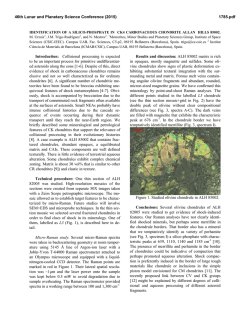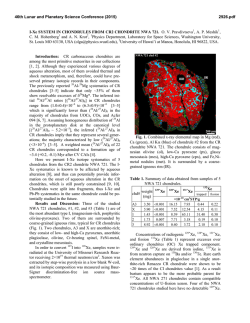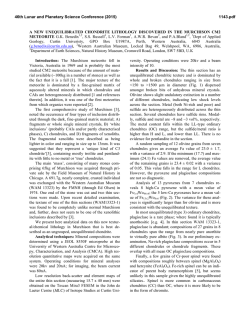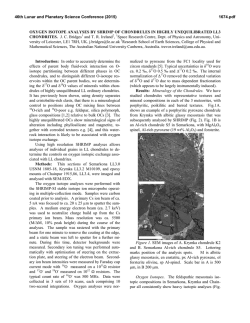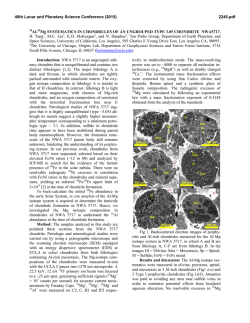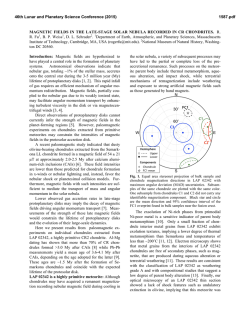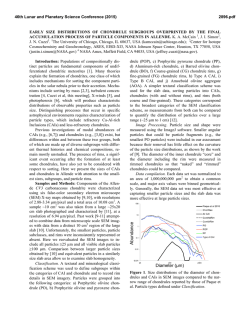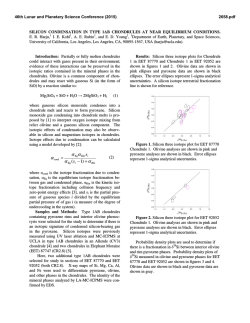
OXYGEN ISOTOPE SYSTEMATICS OF CHONDRULES IN R3
46th Lunar and Planetary Science Conference (2015) 2053.pdf OXYGEN ISOTOPE SYSTEMATICS OF CHONDRULES IN R3 CLASTS: A GENETIC LINK TO ORDINARY CHONDRITES. N. T. Kita1, T. J. Tenner1, C. Defouilloy1, D. Nakashima1,2, T. Ushikubo1,3, and A. Bischoff4, 1WiscSIMS, Department of Geoscience, University of Wisconsin-Madison, WI 53706, USA ([email protected]), 2Tohoku University, Miyagi 980-8578, Japan. 3Kochi Institute for Core Sample Research, JAMSTEC, Kochi 783-8502 Japan. 4Institut für Planetologie, 48149 Münster, Germany. Introduction: Rumuruti (R) chondrites are characterized by high FeO contents in olivine (Fa38) and the highest bulk Δ17O (= δ17O – 0.52 × δ18O) among chondritic meteorites (2.7 ± 0.3‰; [1]). Previous studies indicate that textures and chemistry of chondrules in R chondrites resemble those of ordinary (O) chondrites [2-5]. However, detailed chemical and isotopic investigations of primitive chondrules in R chondrites are hampered by the scarcity of low subtype (<3.5) R3 chondrites. Bischoff et al. [6] report highly unequilibrated R3 clasts in brecciated R chondrites with subtypes lower than 3.5. Kita et al. [7-8] investigated one such R3 clast in Nortwest Africa (NWA) 753 (R3.9), “NWA 753-IX”, and found that the chemistry, texture and oxygen isotope ratios of included chondrules are similar to those in LL3 chondrites reported by [9]. To further investigate primary characteristics of chondrules in R chondrites, we report data from two other R3 clasts, one from the same NWA 753 sample and another from Dar al Gani (DaG) 013 (R3-6). Samples and Methods: The two new clasts “NWA753-VII” and “DaG 013-X” studied are 3×3 mm and 5×8 mm in size, respectively. The petrology and mineral chemistry of the latter is described in [6]. 78 chondrules and fragments were selected for scanning electron microscope (SEM, Hitachi S-3400N) observations. Of these, 26 chondrules were selected for oxygen three isotope analyses using the WiscSIMS IMS 1280 secondary ion mass spectrometer (SIMS); the chondrules met criteria of having multiple clean ≥15 µm areas (6-8 points) among olivine and low-Ca pyroxene phenocrysts for SIMS analyses. Major elements in olivine and pyroxene were analyzed by electron microprobe (EMP, Cameca SX-51). Oxygen three isotope analyses by SIMS employ conditions similar to methods in [9]; the primary beam was ~15µm in diameter with an intensity of 3 nA. Oxygen three isotopes were detected on multi-collection Faraday cups and the typical spot-to-spot reproducibility was 0.3‰ and 0.5‰ for δ18O and δ17O, respectively (2SD). Results: Most chondrules have porphyritic textures with a wide range of Mg# (=[MgO]/[MgO+FeO] molar % of olivine and pyroxene), from 65-100. The abundance of type I (Mg#>90) and type II (Mg#<90) chondrules are roughly equal in two clasts from NWA 753, while type I chondrules are much more abundant in DaG 013-X (Fig. 1). Minor non-porphyritic chon- drules include radial pyroxene (RP) and barred olivine (BO) chondrules. The distributions of Mg# among chondrules in R3 clasts are shown in Fig. 1. They have a peak at Mg#>98 and a relatively smooth distribution towards Mg#~70, with a smaller peak between Mg# 90-80 (Fig. 1a-1c), similar to the distribution among LL3 chondrite chondrules (Fig. 1d). Fig. 1. Histogram of Mg# among chondrules in R3 clasts (a) NWA 753-IX [7], (b) NWA 753-VII, (c) DaG 013-X, and (d) LL3 chondrites [9]. Oxygen isotope ratios of multiple spots (6-8) in each chondrule are similar to each other in most cases. Thus, the average values are calculated for each chondrule and shown in Fig. 2. The majority of data plot above the terrestrial fractionation line (TFL) but significantly below the bulk R chondrite trend (Δ17O =2.7‰ [1]). They plot mainly at the left side of PCM (primitive chondrule mineral) line, which is determined from Acfer 094 [10] and represents the slope 1 line for chondrules in carbonaceous chondrites [e.g., 11-12]. Only data from two chondrules (type I) overlap the range of bulk R chondrite data. Among type I chondrules, IA (olivine-rich) and Al-rich chondrules tend to be depleted in δ18O compared to IB (pyroxene-rich) chondrules along the mass dependent fractionation line, by as much as 6‰. This is very similar to the relationship among type I chondrules in LL3 chondrites [9]. Data from type II chondrules exhibit little variation in δ18O and δ17O; their average Δ17O is 0.83±0.64‰ (2SD), which is similar to the average of type II chondrules in LL3 chondrites (0.54±0.60‰, [9]). Four type I chondrules in NWA 753-IX are 16Orich (Δ17O: –1‰ to –3‰) and plot on and above the PCM line (Fig. 2a). Six chondrules from three clasts have 16O-rich relict olivine grains with Δ17O as low as –7‰, distinctly lower than those of co-existing olivine 46th Lunar and Planetary Science Conference (2015) and pyroxene in the same chondrules. They occur in type I and II chondrules. Similar 16O-rich chondrules or relict olivine grains occur in LL3 chondrites [9]. Fig. 2. Oxygen three isotope ratios of individual chondrules in R3 clasts, averaged from multiple spot analyses. NWA 753-IX data are from [8]. Grey circles are data from bulk R chondrites [1]. TFL, PCM line [10], Young and Russell line (YR, [13]), and carbonaceous chondrite anhydrous mineral line (CCAM, [14]) are shown for reference. Discussion: Chondrules in all three R3 clasts have chemical and isotope characteritics similar to those observed in LL3 chondrites [9]. Thus, chondrules in O and R chondrites could have formed in similar environments with common oxygen isotope reservoirs. Similar Δ17O values (~1‰) in most chondrules suggest that precursor dusts and gases were well-mixed. Such a homogeneous isotope reservoir might have been produced by isotope exchange between solids and solar nebula gas at high temperatures prior to the onset of chondrule formation [9]. Equilibrium fractionation between silicate and H2O/CO gas (as large as –4‰ at 1200˚C) would have resulted in significant δ18O deple- 2053.pdf tion in silicate dusts [9]. In addition, 16O-rich precursors similar to carbonaceous chondrite chondrules that would plot along the PCM line could have contributed to variations in Δ17O among 16O-rich chondrules and relict olivine grains in O and R chondrites. In Fig. 3, Δ17O values of individual chondrules are shown against Mg#. The Mg# of chondrules are an index of oxygen fugacity during chondrule formation, which may be related to dust enrichments of the local disk and abundances of water ice in chondrule precursors [11]. There is a hint of negative correlation for chondrules with Mg# = 99-95. Analogous to the formation of type I chondrules in CR chondrites [11], the correlation may indicate mixing of a 16O-poor oxidizing agent (e.g., ice) and 16O-rich anhydrous dusts. Such a Mg#-Δ17O relationship is not present among type I chondrules in LL3 chondrites [9]. Thus, it seems that the R chondrite accretion region could have been more heterogeneous in oxygen three isotope ratios than that of LL3 chondrites. Type II chondrules are homogeneous in Δ17O, and similar in value to those in LL3 chondrites (e.g. Fig. 3), indicating that they might have formed in dust-enriched regions where multiple isotope reservoirs were thoroughly mixed. Fig. 3. The Mg#-Δ17O relationship of chondrules in R3 clasts. The shaded area represents the mean value and 2SD of type II chondrules in LL3 chondrites [9]. References: [1] Bischoff A. et al. (2011) Chemie der Erde, 71, 101–133. [2] Weisberg M. K. (1991) GCA, 55, 2657-2669. [3] Greenwood J. P. (2000) GCA, 64, 3897-3911. [4] Isa J. et al. (2011) LPS XLII, Abstract #2623. [5] Isa J. et al. (2012) Meteoritics & Planet. Sci., 47, Abstract #5314. [6] Bischoff A. (2000) Meteoritics & Planet. Sci., 35, 699-706. [7] Kita N. T. et al. (2013a) LPS XLIV, Abstract #1784. [8] Kita N. T. et al. (2013b) Meteoritics & Planet. Sci., 48, Abstract #5149. [9] Kita N. T. et al. (2010) GCA, 74, 6610-6635. [10] Ushikubo T. et al. (2012) GCA, 90, 242-264. [11] Tenner T. J. et al. (2015a) GCA, 148, 228-250. [12] Tenner T. J. et al. (2015b) this meeting. [13] Young E. D. and Russell S. S. (1998) Science, 282, 452-455. [14] Clayton R. N. et al. (1977) EPSL, 34, 209-224.
© Copyright 2026
